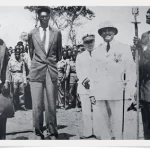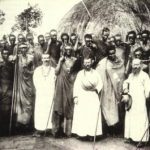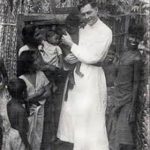The White Fathers’ Mission in Rwanda I
An Overview I
The White Fathers in Rwanda confronted two acute problems: a feudal stratification of society in which the ruling class was anti-Christian, and regional variation within the State such that uniform mission policy was inappropriate’; Their initial recruitment was thanks to the strong-arm methods of Ganda catechists and limited to the poorest Rwandans-seeking powerful patrons:
German commitment to the Tutsi nobility, as agents for the administration of an understaffed colony,reinforced Monsignor Hirth’s desire to convert the chiefs. The Tutsi first ostracised Christians then tried from 1909 to control them by clientship relations. Tensions arose between Fathers’advocating an apostolate to the ruling class and those favouring regionalism and fuller support for the peasant Church. Mission Superiors became a law-unto-themselves causing disputes with Administration, and indirectly resulting in Father Classe’s recall to Europe. When he returned in1922 as Vicar-Apostolic, the Belgian regime, after some indecision, wanted te rule through a Tutsi elite. Educational qualifications for chieftancy increased the power of the Catholic Mission which alone could provide teachers and schools, the nobility split into traditionalists and those seeking further accomodation with, the Europeans: The rush into Church schools heralded a wave of Tutsi conversions and the removal of the king, Musinga, as the traditionalists figurehead. Rudahigwa, the catechumen king, spelt the end of the Hutu church.and a new era of “court Catholicism” in which a Tutsi State Church was born.
From 1900-1932 the White Fathers’Mission was assimilated by Rwandan society and shaped by the conflicting demands of ruling class and peasantry.The Rwandan church that came into being was thus marked by clientship and social conflict as Well as the express policies of the Society of White Fathers.
The encounter between Roman Catholicism and Rwandan society apparently provides an ideal topic for a ‘culture contac’ study. But the model of one culture meeting another to generate within it far-reaching changes seems inappropriate in the case of Rwanda; it neglects both the homeostasis and dialectical development of Rwanda society. There were only a handful of colonial officers and some dispersed missionaries set in a large State and range against an ancient monarchy. Indeed, the policy of Indirect Rule in Africa has been a tacit admission that in same circumstances such a modal is both incongruous and impracticable.
‘The Hamites’, whom colonial administrators took to be superior races, were granted, at least in theor, a right to a history and a future almost as noble as their European cousins. In the tinkering post-military phase of Indirect Rule, it’was common sense to assess the ‘direction’ and internal dynamics of pre-colonial ‘Hamitic’ States, even to worry about the sources of conflict and dysfunction within them. So the historian who tries to set missionary activity into the framework of the internal evolution of an African State, whether Fulani or Tutsi, is not doing anything essentially new. He is perhaps more aware of the pitfalls; firstly the over-present danger of a facile evolutionary and linear reduction of a camplex history: secondly the near impossibility of separating any structure or direction from the historiographical premises behind an orally transmitted history.
Rwanda’s oral traditions provide a case study of the subservience of history to political ends:
“All cultures are myth sustained in that they derive their legitimacy from a body of values and beliefs which tend to embellish or falsify historical truth. But some more than others”. If the writer is foreed to discuss first the historiography of Rwanda, it is not just that the country’s oral and written history provides a pre-eminent example of the affects of ideologiaal restraints, but also that a particular account of the past,shaped in the Tutsi court and promulgated by the Catholic clergy, influeneed the political coneciousness of both Rwandans and Europeans. The racist pre-conceptions of the Hamitic hypothesis found spurious confirmation in the apparently ethnic basis of the divisions in Rwanda’s stratified society: Colonial and related mission policies guaranteed that erroneous prophecies based on racist premises, would be fulfilled. The writing down of Rwandan history, part of the cultural work undertaken by the Catholioc Church, has to be considered alongside its socio-economic and educational activities. Rwandan Catholic history contributed to a view society in which pluralism gave way to dualism, the stark confrontation between Hutu and Tutsi.
Father Pagès : Un Royaume H.amite au Centre de l’Afrique, first published in 1933 and the erliest of the Catholioc ‘Hamitic’ histories, was far from the propaganda of a court historian. The important point for Pagès was- that the ‘Hamites’, had once been Christian; the White Fathers were taking up where Coptic Christianity had left off, on the borders of Ethiopia. While drawing heavily on Tutsi informants and court traditions, ibitekerezo, he was too sophisticated to be unaware of’ bias. Descartes appears most relevantly in the introduction:
« S’ils ne changent ni n’augmenent les choses pour les rendre plus dignes d’étre lues, les historiens en omettent presque toujours les plus basses et les moins illustres-, d’où vient que le reste ne paraît pas ce qu’il est ».
The second mainstay Catholic orthodoxy in the colonial period was an equally fascinating book by Chanoine de Lacger, Le Ruanda. He elaborates works to present Rwanda’pro-colonial history as the type of an African Old Testament: A romantic assessment of European feudal society is projected into the Hamitic past, and, since the book was stimulated by a massive influx of Tutsi into the Church, he is naturally disinclined to subject colonial catholic society to deep criticism. Yet the historical superiority of the Tutsi and their divine right to rule is offset.by panegyrics to the Hutu peasant.
«C’est le cultivateur qui s’empare de la terre, la transforme, lui imprime un cachet d’humanite, crée le paysage historique… Au Ruanda ce conquérant, ce transformateur ce fût le paysan bantu, le muhutu. C’est lui qui a fait reculer la forêt, a tracé le premier réseau de sentes durables-, a parsemé la campagne d’enclos verts et de foyers; lui, qui, se multipliant comme les étoiles du ciel et le sable des mers, a rempli de sa présence les soixante mille kilomètres carrés ou se parle sa langue ».
Because its aim is to describe the birth of a Christian kingdom, the book supports the court version, yet de Lacger’s biblicism and mediaevalism protect him from the racist excesses of Belgian writers and push him’almost to a class analysis of Rwandan society.
The Rwandan court found its first conscious and talented propagandist-when Abbé Alexis Kagame began writing in 1938. Coming from a family of abiru court historians, he had unique eccess to the royal esoterioc codes. In his work the cultural riches of the court are presented from the viewpoint of a Tutsi nationalist historian. If Pagès is obeying the directives of his Society and dipping into local culture; and de Lacger writing the edifying story of the first Christian State after Ethiopia, Kagame is skilfully setting out the cultural and historical justification for the future independence of Church and State under Tutsi control.
To quote Vansina’s harsh verdict, these three clerics produced ‘une déformation systématique’ of Rwanda’s history. On the authority of Kagame; the Tutsi Nyiginya dynasty was given a spurious longevity and continuity. By using an Ile -de-France model of the .nuclear Rwandan State, projecting the clientship relationship of ubuhake into the past and ignoring the important question of the ancient clan system; Rwanda’s history was presented as a progressive domination of other Tutsi states and minor Hutu kingdoms through conquest and the institution of ubuhake. The direction of this process; was expansion, consolidation by clientship and centralisation of power in the person of the Nyiginya mwami, ( pl: abami). Like the portrayal of Africans in the old colonial histories, the Hutus’s role in this saga was that of passive recipients of more -or-less good Tutsi government. Obviously a gross oversimplification; this was essentially the story gleaned by Missionaries and Residents from the Catholic-court orthodoxy.
Vansina’s seminal essay, L’Évolution du royaume Rwanda, des origines à 1900, researched before 1961 in a period of mounting political consciousness amongst educated Hutu, went a long way towards a demythologisation of ‘Hamitic’ history. He demonstratedconvinaingly the devices used in traditions to disguise diefeats and foreign conquest which overthrew dynasties. By laying bare the stereotypes and disposing off many early abami as mythical; he reduced Kagame’s chronology by some four hundred years and lent ,weight to the hypothesis; that the supposedly Nyiginya hero king, Ruganzu Ndori; was usurper from Karagwe. But he did not go far enough. D’Hertefelt; was able to acouse him justifiably of ‘pan-tuutsisme’in his uncritical acceptance of ‘Tutsi’ clans whose class distribution; d’Hertefelt demonstred; indieates a Hutu origin.
D’Hertefelt was the first author to address himself to the problem of the multi-class character of Rwandan clans. Using numerical data from election rturns, he put the social structure of the pre-colonial State in a new perspective. His analysis of class distribution demonstreed that marriage between Hutu and Tutsi was not the rarity that had formerly been supposed; Hutu became ennobled while Tutsi slipped into the agricultural stratum of society through poverty or misfortune. In contrast to Maquet’s picture of a closed caste system in which impoverished Tutsi were supported by their peers, d’Hertfelt, like de Lacger, emphasised the importance of social mobility and rejected Maquet’s alleged ‘récupération fonctionelle’. The Tutsi-Hutu distinction seems only to have taken on overriding importance at the end of the nineteenth century with increasiniv stratification of society and colonial rule; at least it is useful as an observer’s construct for understanding; society at this time.
Thus, the use of the term ‘caste’ inappropriate in the 1ight of d’Hertefelt’s research and the term’class’ will be used in its place. That’s this distinction between a cattle-owning aristocrate and a subject peasantry came finally to be understood and lived as one of ethnic origin is typical of situations of class conflict in which language, religion or physical attributes provide a shorthand for identifying groups whose true natures require an objective view of the total society. This is not to say, though, that the Rwandan revolution of 1959-1961 was a class struggle rather than a competition between two elites, and little merit can be claimed for the term ‘class’ other than convenience.
Ontogeny does not recapitulate phylogeny nor can the Rwandan hierarchy of Tutsi, Hutu and Twa be neatly, dismantled into three historical stages. Any such escape from the ethnographic present, or the ethnographic 1930s, is illusory. The Hutu certainly owned cattle before the arrival of the Tutsi, so the hunter-gatherer, agriculturalist and pastoralist modes of life offer no evolutionary sequence• Nonetheless, since much of Rwanda was once forested, its earliest inhabitants must have relied heavily on hunting and gatheringi supplemented perhaps by a few crops planted in clearings and along the edge of swamps. Rwanda’s agriculturalist are known to have made iron hoes and ‘roulette’ decorated pottery, planted sorghum and made inroads on the primaeval forerst.
The smallest Hutu social unit is, today, the minor patrilineage, inzu, of up to six generations in depth; in the north the major patrilineage, umuryango, is functionally a more important grouping. Hutu lineages together make up a clan, ubwoko, which may be divided into sub-clans ishanga. Land is held communally by the head of an inzu and his descendants, although only the lineage head has the right to grant vacant cleared land; uncultivated land could be allocated to sons and strangers. It seems likely that this form of weak lineage and clan leadership is ancient and perhaps typical of the pre-Tutsi period, though this is more conjecture.
As long as there remained forest to be cleared population increase could be accommodated and new arrivals settled. During the colonial period in Bugoyi, usufruct rights over a piece of land might be given by lineage heads for a year, kwatisha, in exchange for hoes and part of the pea harvest. Rights for an indefinite period, gufaha, required the presentation or a goat and beer at each subsequent harvest. True patron-client relationship grew up in the system of ubukonde in which land was alienated and marked out by limiting tees or a ditch. The client was allowed two years in which to cultivate the land and would send the occasional calabash of beer to the patron; after this period the client had to provide two days labour in the sowing season, October and November and during the May sorghum harvest. Often the umukonde formed a blood pact with the client or a marriage alliance with his inzu. Each inzu held an inalienable plot banded on from father to sons,on leaving the region an inzu returned the plot to the clan but had the right to reclaim it. This type of land ownership was typical of the rich volcanic plain of the north west, and extended into Uganda.
In the 1930s when the Belgians turned an anthropological eye on Rwanda, they found a wide range of socio-economic relationships in Hutu society, none of which co-incided with the Western concept or contract. Relationships within the patrilineage involved the provision of land and labour and were characterised by mutual help and protection. Relationships across lineage lines were recorded by the exchange or land, women, animal or hoes, and implied a degree of subordination. Vendettas could be ended by the provision of a woman to give birth to a substitute for the dead member of the inzu, and the payment of eight cows or goats.
Lineage religion was centered on the veneration and appeasement of ancestors whose invisible presence was felt to be important for the well-being of the inzu. Deceased lineage members were offered symbolic sacrifices of small pieces of food, and sometimes; ‘married’ to young girls who attended their spirit-houses. The ancestral spirits, abazimu were generally thought to be malevolent in their activity and personal misfortunes were attributed to them after divination by an umupfumu. The lineage head was in charge of the spiritual well-being of the inzu with the same communal responsibility as he exercised oven the conceptually related land.
The link between the local umuryango and the scattered widespread clan was of a purely rituel kind a common totem and annual sacrifice to an eponymous ancestor at the Erythrina or sycamore tree. Representatives of the imiryango provided food and beer which were offered with prayers by the clan head. The Singa of Bugoyi sent three cows for clan ceremonies in Mulera, one of which was sacrified while the other two passed into the herd of the clan head. Strangers claiming clan membership were asked to pray the Erythrina tree to test their allegiance to the clan ancestors.
Amongst the Shobyo of Bugoyi, the head of the sub-clan was considered to be filled with a spirit of the eponymous ancestor; clad in a civer head-dress; he blew the spirit into an antelope horn. The assembled elders followed suit. The horn then represented the permanent presence of the ancestor for the sub-clan and was used to cure the sick and impart spiritual power to those about to go into battle. Sveral of the northern Hutu clans appear to have kept such ritual objects as blocks of hyaline quartz and ivory horns as clan fetishes. An essentiel element in such supra-lineage religion was the provision of powerful spiritual protection to clan members. This type of organisation surviving in the north-west in which the head of the umuryango was the sole effective political- agent, elected and assisted by elders, was probably an exception in Central Rwanda after the arrival of the Tutsi.
https://uk.amateka.net/the-white-fathers-mission-in-rwanda-i/https://uk.amateka.net/wp-content/uploads/2019/10/catho_mission.jpghttps://uk.amateka.net/wp-content/uploads/2019/10/catho_mission-150x150.jpgMissionary historyAn Overview I The White Fathers in Rwanda confronted two acute problems: a feudal stratification of society in which the ruling class was anti-Christian, and regional variation within the State such that uniform mission policy was inappropriate'; Their initial recruitment was thanks to the strong-arm methods of Ganda catechists and...BarataBarata rpierre@ikaze.netAdministratorAMATEKA | HISTORY OF RWANDA



